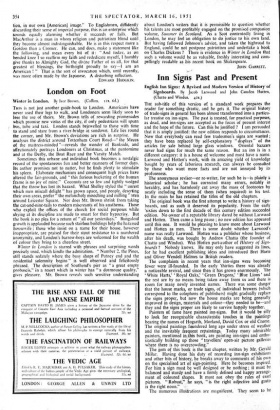Inn Signs Past and Present
English Inn Signs: A Ikevised and Modern Version of History of Signboards. By Jacob Larwood and John Camden fintien. (Chatto and Windus. 423.)
The sub-title of this version of a standard work prepares the reader for something drastic, and he gets it. The original history of trade-signs in general has been almost transformed into a particu- lar treatise on inn-signs. The past is treated, for practical purposes, as dead, and inn-signs are accepted as the focus of present interest and the hope of the future. Can this be justified ? I am persuaded that it is amply justified: the new edition responds to circumstances. Now that everybody can read few tradesmen's signs are wanted ; they have been replaced by self-explanatory " displays " of the articles for sale behind large glass windows. Oriental bazaars never had signs for much the same reason. But an inn is in a different category: it is a house of welcome and must have a name. Larwood and Hotten's work, with its amazing yield of knowledge bought by years of laborious research, can always be consulted by those who want more facts and are not annoyed by its profuseness.
The anonymous reviser—or re-writer, for such he is—is plainly a historical scholar ; he has corrected many errors, notably in heraldry, and has harmlessly cut away the mass of footnotes by neatly including the sense of them (when required) in his text. In the main he has retained the titles of the old chapters.
The original book was the first attempt to write a history of sign- boards, and as such it deserved its popularity. From the early 'sixties down to the first decade of this century edition succeeded edition. No owner of a reputable library dared be without Larwood and Hotten. Then came a long pause ; no new edition has appeared until this one. It would be pleasing to know more about Larwood and Hotten as men. There is some doubt whether Larwood's name was really Larwood. Hotten was a publisher whose business, after his death, was bought by Andrew Chatto (the founder of Chatto and Windus). Was Hotten part-author of History of Sign- boards? Nobody knows. He may only have suggested its lines, for he had excellent publishing ideas and introduced Bret Harte and Oliver Wendell Holmes to British readers.
The complaints in recent years that inn-signs were becoming fewer were ill-founded. In the early 'thirties there was already a noticeable revival, and since then it has grown enormously. 1 he ' White Harts,' Royal Oaks,' Green Dragons, Blue Lions' and the rest are by no means being taken away from us and there is room for many newly invented names. There was some danger that the house marks, or trade signs, of individual brewers (which correspond to the colophons of publishers) might gradually replace the signs proper, but now the house marks are being generally improved in design, materials and colour—they needed to be—and they and the signs proper are likely to survive happily together.
Painters of fame have painted inn-signs. But it would be silly to look for recognisable characteristic touches in the paintings bearing the names of Hogarth, Morland, David Cox or old Crome. The original paintings foundered long ago under stress of weather and the inevitably frequent repaintings. Today many admirable painters, mentioned in -this book, are painting inn-signs and enthu- siastically building up those " travellers' open-air picture galleries where there is no overcrowding."
The gem of this book is the last chapter, written by Mr. Gerald Millar. Having done his duty of recording inn-sign exhibitions and other bits of history, he breaks away to comments of his own on the specialised art of sign-painting. Here he becomes inspired. For him a sign must be well designed or be nothing ; it must be balanced and sturdy and have a firmly defined and happy arrange- ment of coloured shapes. It must not obey the rules of easel pictures. "Robust," he says, " is the right adjective and gusto is the right noun." The numerous illustrations are magnificent. They seem to be
almost arrogant towards the small drab woodcuts of Larwood Fiction
and Hotten. A special word of praise is due to the reproductions of eighteenth-century billheads, not because these challenge the luxuriance of the larger plates but because they delight the eye











































 Previous page
Previous page